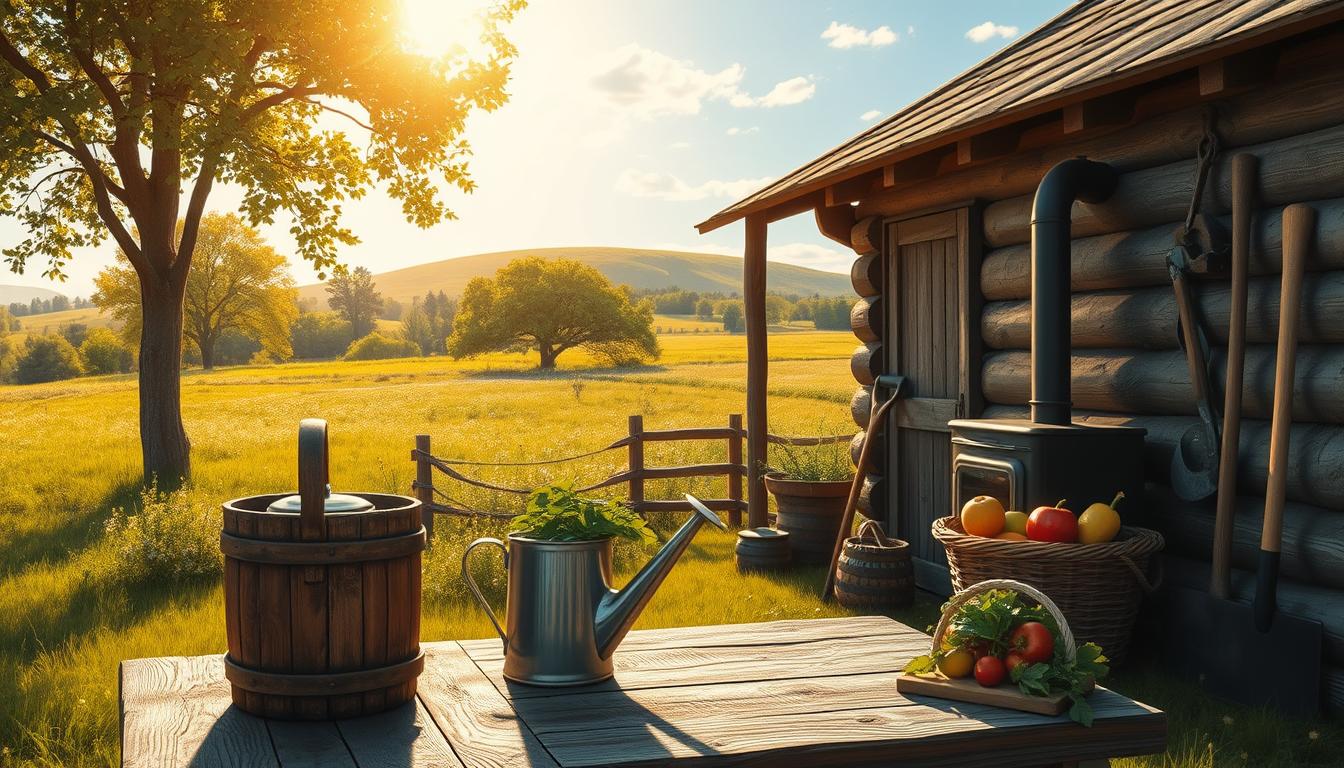Homesteading has seen a 200% surge in interest over the past two years, as more families seek self-sufficiency and a deeper connection to their food sources. This lifestyle isn’t just for rural areas—85% of modern homesteaders begin their journey in urban or suburban settings.
According to 2023 USDA data, 63% of new homesteaders start small, often with container gardens or a few chickens. Even a balcony can be the first step toward growing your own herbs or vegetables. Many find that homesteading is about incremental progress, building skills over time.
Polyface Farm’s study highlights that 72% of successful homesteads began with small, manageable projects. Whether you’re on a 5-acre property or less than an acre, homesteading is adaptable to your space and lifestyle. It’s about creating a sustainable future for your family, one step at a time.
Key Takeaways
- Homesteading has grown in popularity, with many starting in urban or suburban areas.
- Begin small with container gardens or small livestock to build skills.
- Homesteading is adaptable to any space, even less than an acre.
- Incremental progress is key to long-term success.
- Focus on self-sufficiency and reconnecting with food sources.
What Is Homesteading and Why Start One?
Self-sufficiency is at the heart of the homesteading movement. Today, it’s about consciously stepping away from industrial food systems and embracing a more sustainable lifestyle. Unlike the 19th-century Homestead Act, which required settlers to cultivate 160 acres, modern homesteading can thrive in urban chicken coops or suburban gardens.
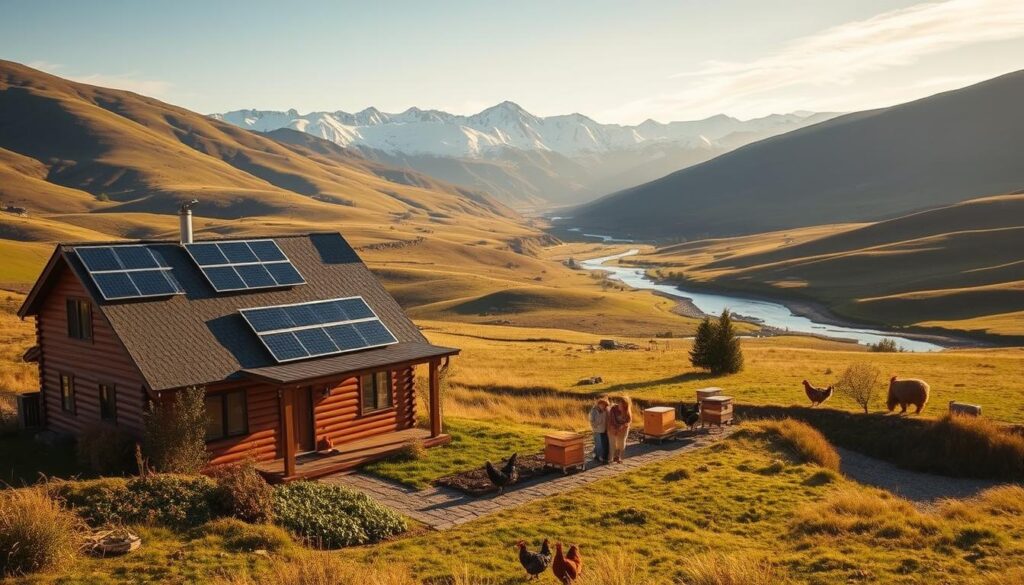
Why are so many people drawn to this lifestyle? A 2024 Homesteaders of America survey found that 78% of respondents prioritize food security. Beyond that, mental health benefits are significant. A University of Vermont study revealed a 68% reduction in stress markers among those who engage in homesteading activities.
Common motivations include:
- Food safety (34%)
- Environmental concerns (29%)
- Financial resilience (22%)
“Homesteading isn’t just about growing your own food; it’s about reclaiming control over your life.”
Leah Payne’s journey is a testament to this. She transitioned from a city apartment to a 20-acre working farm, proving that homesteading is adaptable to any space or situation. Whether you’re in a rural area or an urban setting, the principles of self-sufficiency remain the same.
| Motivation | Percentage |
|---|---|
| Food Safety | 34% |
| Environmental Concerns | 29% |
| Financial Resilience | 22% |
In essence, homesteading is about creating a life that aligns with your values. It’s a journey toward independence, sustainability, and a deeper connection to the food you consume.
Define Your Homesteading Goals
Setting clear goals is the foundation of a successful homesteading journey. Without a well-defined vision, it’s easy to lose focus or overspend on unnecessary projects. A Farm Journal survey revealed that 92% of failed homesteads lacked written 5-year plans. Taking the time to outline your goals ensures long-term success.
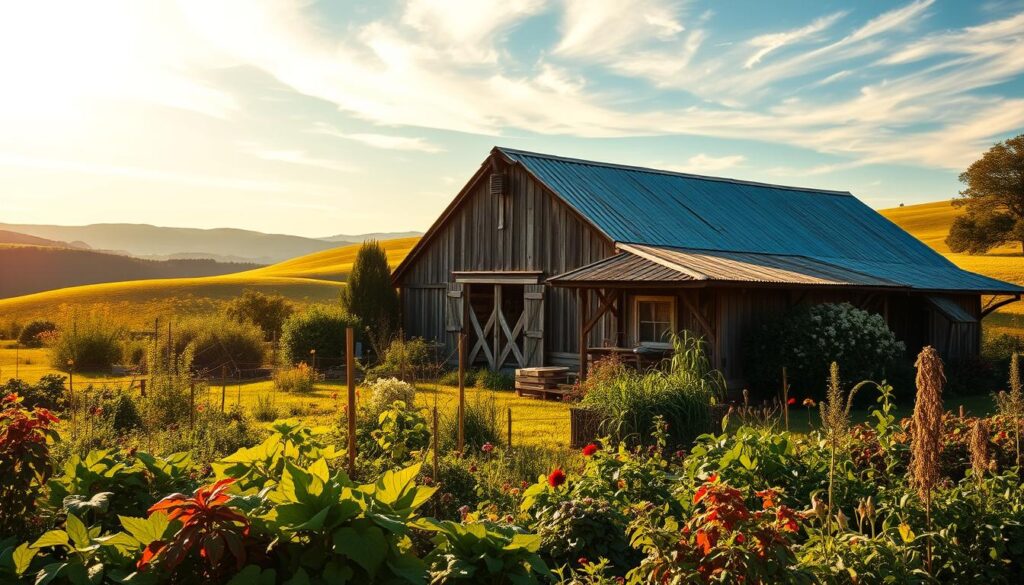
Start by deciding between off-grid and hybrid systems. Off-grid setups offer complete independence but require significant upfront investment. Hybrid systems, on the other hand, combine traditional utilities with renewable energy, making them more accessible for beginners.
Next, consider livestock choices based on your space and family needs. Chickens are a popular starting point, while goats or sheep may require more land. Use this decision matrix to guide your choices:
- Off-grid vs Hybrid: Energy independence vs affordability.
- Livestock Types: Space requirements and maintenance.
- Infrastructure Priorities: Water systems > barns > orchards.
Joel Salatin’s 7-step goal-setting framework is a valuable tool for homesteaders. It includes defining your vision, assessing resources, and creating actionable steps. This approach helps break down long-term goals into manageable tasks.
“A clear plan turns dreams into achievable milestones.”
Take inspiration from a Minnesota family who transitioned from CSA members to full-time producers over 10 years. Their journey highlights the importance of patience and incremental progress. Avoid “YouTube envy”—61% of new homesteaders overspend on unnecessary tech. Focus on essentials like water systems and barns before expanding.
Use this interactive checklist to prioritize your infrastructure needs:
- Water systems: Ensure reliable access.
- Barns: Shelter for livestock and storage.
- Orchards: Long-term food production.
By defining your goals and creating a realistic plan, you’ll set the stage for a thriving homestead. Remember, homesteading is a journey, not a race. Take the time to build your skills and resources over the years.
How to Start a Homestead: The First Steps
Embarking on a homesteading journey begins with small, thoughtful steps. According to Mother Earth News, 54% of successful homesteads started with investments under $500. This proves that you don’t need a large budget or vast land to begin. Focus on testing your readiness and gathering essential tools.
One practical way to test your commitment is the 72-hour chick-raising challenge. Try raising chicks in your basement before building a coop. This small experiment helps you understand the responsibilities of livestock care without significant upfront costs.
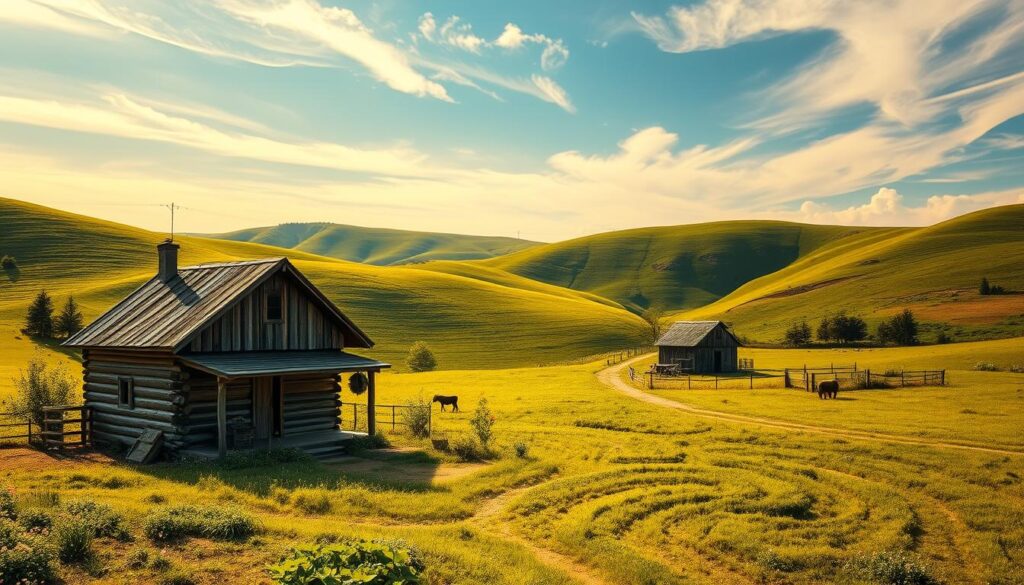
Equipping yourself with the right tools is crucial. Here’s a list of 15 essentials under $100:
- Broadfork for soil aeration
- Canning kit for food preservation
- Root cellar thermometer for storage
- Hand trowel for gardening
- Pruning shears for trimming plants
Understanding your family’s food needs is another key step. The USDA’s “Food Availability Chart” helps calculate how much to grow or raise. For example, a family of four might need 200 pounds of vegetables annually. Use this chart to plan your garden or livestock.
Urban dwellers can explore the “Micro-Homestead Certification” program. This initiative supports small-scale, city-based projects like balcony gardens or indoor fermentation. It’s a great way to connect with like-minded individuals and gain recognition for your efforts.
Here are three inspiring examples of families who started their homesteading journeys in different settings:
| Family | Setting | Focus |
|---|---|---|
| Apartment Fermenters | Urban | Kombucha and kimchi production |
| Suburban Beekeepers | Suburban | Honey and pollination |
| Rural Regenerative Farmers | Rural | Soil health and crop rotation |
Starting a homestead is about taking small, deliberate steps. Whether you’re in an apartment, suburb, or rural area, the principles remain the same. Focus on testing, planning, and building your skills over time. With the right approach, you can create a sustainable and fulfilling lifestyle.
Create a Budget for Your Homestead
Planning your finances is a critical step in building a sustainable homestead. Whether you’re starting on a 5-acre rural property or a small urban plot, understanding your budget ensures you allocate money wisely. On average, rural setups cost $8,450, while urban homesteads can begin with as little as $1,200.

Cutting Costs and Prioritizing Expenses
Dave Ramsey’s “Homestead Snowball” method is a great way to manage debt. Focus on paying off smaller debts first, then gradually tackle larger ones. This approach helps you free up money for essential homesteading projects.
Hidden expenses can quickly add up. Annual feed costs have risen by 23%, and equipment maintenance accounts for 18% of yearly expenses. Being aware of these costs helps you plan better and avoid surprises.
Take inspiration from an Idaho family who built a $300/month pasture-raised egg business. Their success shows how small-scale ventures can generate steady income while covering daily expenses.
Did you know there are unexpected tax deductions for homesteaders? Here are 12 you might qualify for:
- Mileage for beehive maintenance
- Electricity used for seed starting
- Water systems installation
- Livestock feed storage
- Fencing materials
Another way to save money is through the “Barter Matrix.” Trade your produce or services with local craftsmen for tools or supplies. This system fosters community connections while reducing expenses.
“A solid budget is the foundation of a thriving homestead. It’s not about how much you spend, but how wisely you allocate your resources.”
By creating a detailed budget, you’ll ensure your homesteading journey is both sustainable and financially sound. Focus on essentials, plan for hidden costs, and explore creative ways to stretch your income.
Assess Your Property for Homesteading
Before breaking ground, assess your land for its homesteading potential. A thorough evaluation ensures you understand its strengths and limitations. According to the National Agricultural Law Center, 38% of homesteaders face legal challenges. Avoiding these issues starts with a clear understanding of your property.

Understanding Zoning and Permits
Zoning laws can make or break your homesteading plans. Agricultural, residential, and mixed-use classifications each have unique requirements. Research local regulations to ensure your property aligns with your goals. For example, raising chickens may be restricted in certain residential areas.
Soil quality is another critical factor. Conduct a deep dive into NPK ratios and micronutrient balancing. Healthy soil supports robust crops and sustainable farming practices. Use a soil testing kit to identify areas for improvement.
Water rights are equally important. Riparian and prior appropriation doctrines govern access to water sources. Understanding these laws ensures you have reliable access for irrigation and livestock.
- Zoning Decoder: Agricultural vs residential vs mixed-use classifications.
- Soil Testing: NPK ratios vs micronutrient balancing.
- Water Rights: Riparian vs prior appropriation doctrines.
- Sun Mapping: Use the Solmetric SunEye tool for optimal placement.
“Navigating zoning laws and water rights can be complex, but it’s essential for a successful homestead.”
Sun mapping is a valuable tool for planning your homestead. The Solmetric SunEye tool helps identify the best locations for gardens, solar panels, and structures. Maximizing sunlight ensures efficient energy use and healthy plant growth.
Consider the case of a Colorado family who successfully navigated HOA poultry restrictions. By understanding local zoning laws and building a strong case, they gained approval for their backyard chickens. Their story highlights the importance of research and persistence.
Assessing your property is the foundation of a thriving homestead. From soil testing to water rights, every detail matters. Take the time to evaluate your land and plan accordingly for long-term success.
Start Small: Homesteading in Limited Spaces
Limited space doesn’t mean limited potential for homesteaders. Even in the city, innovative solutions can turn balconies, rooftops, and small yards into productive areas. A Johns Hopkins study found that just 1/8 acre can yield 640 pounds of vegetables annually. This proves that small spaces can be incredibly efficient.
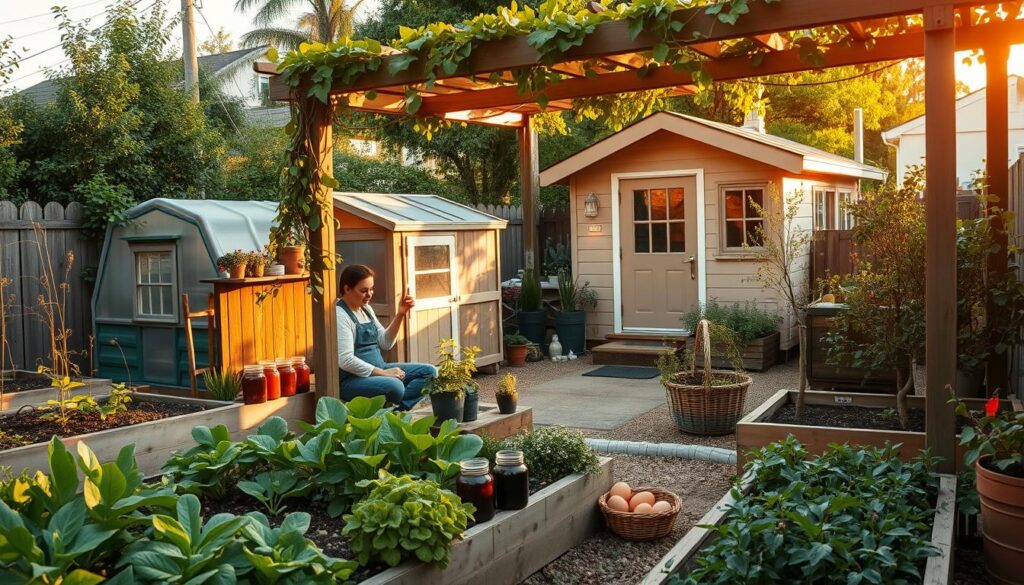
Vertical farming is a game-changer for those with limited room. Designs for 100-square-foot balconies maximize space by growing upward. Herbs, greens, and even tomatoes thrive in vertical setups. For homesteaders in apartments, this method is both practical and rewarding.
“Closet Livestock” is another creative option. Quail, rabbits, and mealworms require minimal space and provide valuable resources. Quail eggs are nutrient-dense, rabbits offer meat and fur, and mealworms are a protein-rich feed for other animals. These options are perfect for small spaces.
Herb gardens can thrive year-round with a 4-season window sill rotation chart. Basil, parsley, and mint grow well indoors, providing fresh flavors for every meal. This simple setup is ideal for urban homesteaders.
Composting in apartments is easier than ever. Compare Bokashi systems and worm towers to find the best fit for your home. Both methods turn kitchen scraps into nutrient-rich compost, reducing waste and enriching soil.
Take inspiration from a Brooklyn family producing 40% of their protein through aquaponics. Their system combines fish farming with hydroponic gardening, creating a sustainable loop. This innovative approach shows what’s possible in the city.
| Method | Space Required | Benefits |
|---|---|---|
| Vertical Farming | 100 sqft | Maximizes space, grows fresh produce |
| Closet Livestock | Small enclosures | Provides eggs, meat, and protein |
| Window Sill Herbs | Minimal | Year-round fresh flavors |
| Apartment Composting | Compact | Reduces waste, enriches soil |
Homesteading in small spaces is about creativity and resourcefulness. Whether you’re in an apartment or a tiny yard, these methods can help you achieve self-sufficiency. Start small, think big, and watch your home transform into a thriving homestead.
Choose the Right Livestock for Your Homestead
Selecting the right livestock is a cornerstone of successful homesteading. Whether you’re raising chickens for eggs or meat, understanding your options ensures a sustainable and productive setup. Heritage breeds, for example, lay 30% fewer eggs but command a 200% price premium due to their unique qualities.
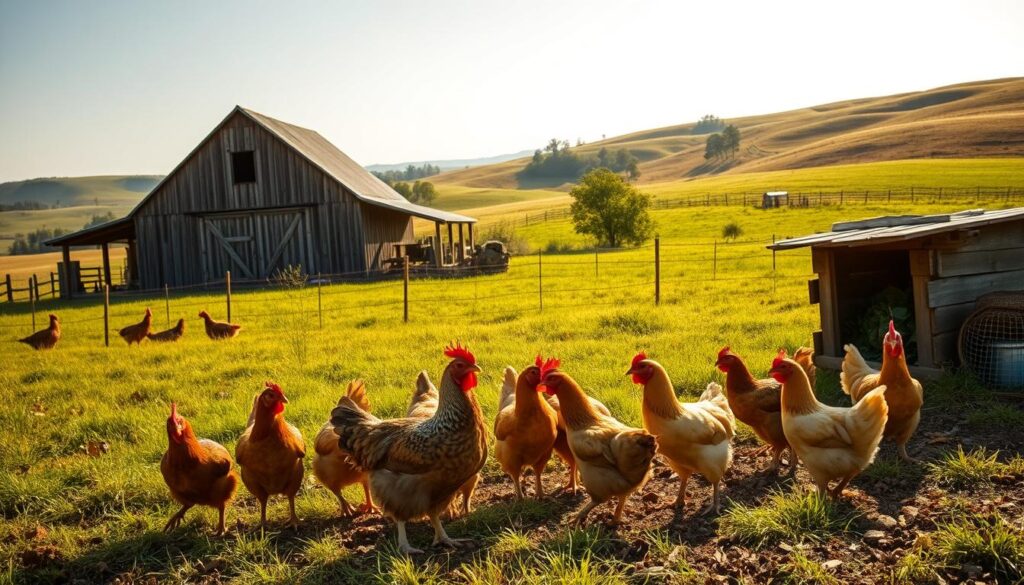
Dual-Purpose Breeds: Plymouth Rocks vs Orpingtons
When choosing chickens, dual-purpose breeds like Plymouth Rocks and Orpingtons are popular. Both offer a balance of egg production and meat quality. Here’s a quick comparison:
| Breed | Egg Production | Meat Quality |
|---|---|---|
| Plymouth Rocks | 200-280 eggs/year | Excellent |
| Orpingtons | 180-240 eggs/year | Good |
Pastured operations often yield healthier animals and higher-quality meat, though they require more space. Confinement systems are cost-effective but may limit natural behaviors.
Butchering Yields and FDA Protocols
Understanding butchering yields is essential for meat production. A 4-pound bird typically provides 65% edible parts. Proper handling ensures quality and safety. Follow FDA-compliant protocols for washing and storing eggs to maintain freshness and prevent contamination.
“A well-designed coop not only protects your chickens but also enhances their productivity.”
A Vermont case study highlights the importance of coop design. Their innovative setup reduced predator losses by 81%, ensuring a thriving flock. Investing in a secure and functional coop is a smart move for any homesteader.
For more tips on raising livestock, check out our guide on gardening for beginners. It’s a great resource for integrating animal care with sustainable gardening practices.
Start a Garden for Self-Sufficiency
Growing your own garden is a powerful step toward self-sufficiency. A well-designed garden can provide fresh, nutritious food for your family while reducing reliance on external sources. According to the Rodale Institute, just 1/4 acre of land can feed a family of four with proper crop rotation and planning.
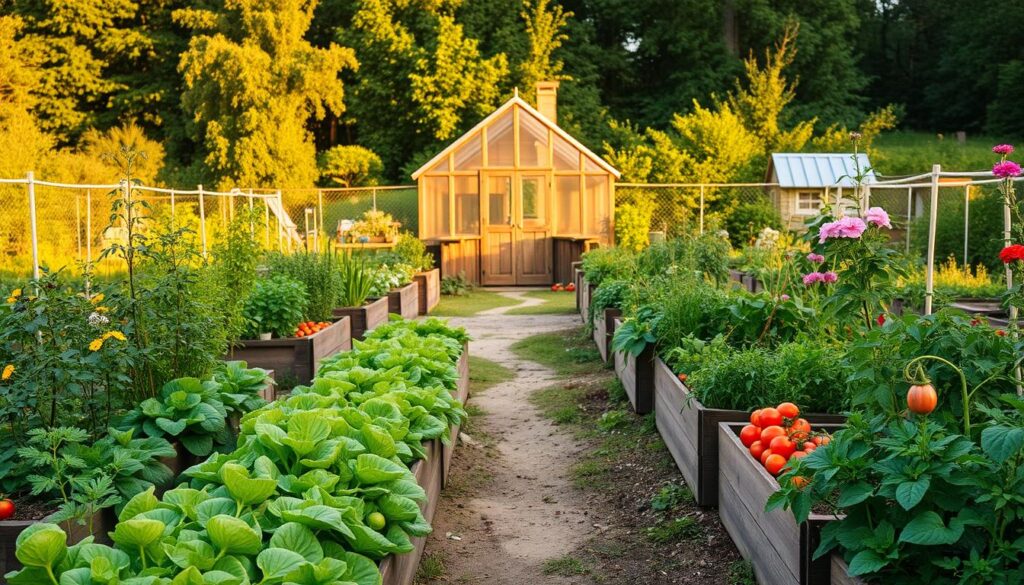
Biointensive planting calendars tailored to 7 USDA zones ensure optimal growth for your crops. These calendars help you maximize space and yield, making your garden more productive. Whether you’re in a warm southern climate or a cooler northern region, there’s a plan for your soil and conditions.
Preserving Your Harvest
Preserving your harvest ensures you enjoy homegrown food throughout the year. Methods like freeze-drying, canning, and root cellaring each have unique benefits. Freeze-drying retains nutrients, canning is cost-effective, and root cellaring extends shelf life naturally.
Heirloom seeds are a great investment for long-term sustainability. Tomatoes, for example, remain viable for 4-7 years, while onions last about 1 year. Knowing seed viability helps you plan your garden and reduce waste.
Fermentation is another excellent preservation method. Recipes like 18-month sauerkraut and 3-day beet kvass are easy to make and packed with probiotics. These fermented foods add variety and health benefits to your diet.
For those interested in solar energy, building a solar dehydrator can boost efficiency by 23%. This eco-friendly tool dries fruits, vegetables, and herbs, preserving them without electricity.
| Preservation Method | Benefits |
|---|---|
| Freeze-Drying | Retains nutrients, long shelf life |
| Canning | Cost-effective, versatile |
| Root Cellaring | Natural, energy-free |
| Fermentation | Adds probiotics, enhances flavor |
| Solar Dehydrator | Eco-friendly, efficient |
By starting a garden and mastering preservation techniques, you can achieve true self-sufficiency. These steps not only provide fresh food but also connect you to the land and its resources.
Learn Essential Homesteading Skills
Mastering essential skills is the backbone of a thriving homestead. Whether you’re new to this lifestyle or refining your expertise, building a diverse skill set ensures long-term success. Studies show that 68% of homesteaders take three or more years to achieve basic proficiency. This journey is about patience, practice, and continuous learning.
Start with a master list of 127 skills, ranked by difficulty and priority. From gardening and animal care to carpentry and food preservation, this guide helps you focus on what matters most. Tackling high-priority tasks first sets a strong foundation for your homestead.
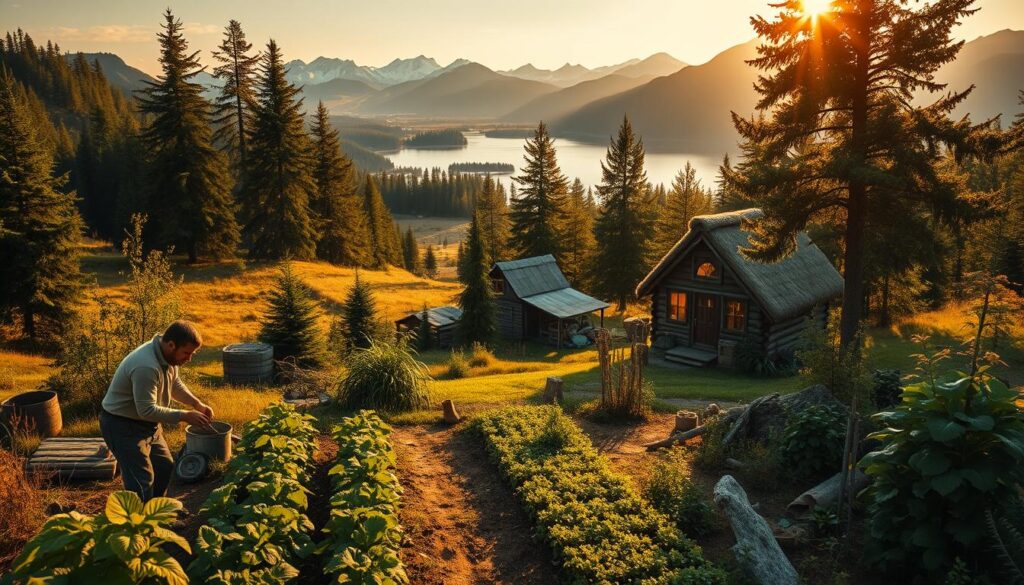
Forge alliances with experienced homesteaders to accelerate your learning. Organizations like ABANA offer blacksmithing apprenticeships, teaching valuable techniques for tool-making and repairs. These partnerships not only build skills but also foster a sense of community.
Understanding water management is crucial. Did you know that one inch of rain can yield 600 gallons of water from a 1,000-square-foot roof? Simple math like this helps you design efficient rainwater collection systems, ensuring a reliable supply for your homestead.
Off-grid power systems are another key area to explore. Compare solar, wind, and micro-hydro options to find the best fit for your property. Each system has unique benefits, from solar’s reliability to wind’s scalability. Choosing the right setup ensures energy independence.
“Preparedness is not just about having the right tools; it’s about knowing how to use them effectively.”
Take inspiration from a Missouri widow who developed a robust disaster preparedness regimen. Her approach combines practical skills with strategic planning, proving that even small homesteads can thrive in challenging conditions.
By dedicating time to learning and practicing these skills, you’ll build a resilient and self-sufficient homestead. Remember, every step forward brings you closer to your goals.
Build a Homesteading Community
Building a strong community is essential for homesteading success. According to the Farmers’ Alliance, 94% of thriving homesteads rely on cooperative networks. These connections provide support, resources, and shared knowledge, making the journey easier and more fulfilling.
National organizations like WWOOFF and NIFA offer valuable resources for homesteaders. These groups connect people across the country, fostering collaboration and learning. Whether you’re in a rural area or an urban setting, these networks can help you grow.
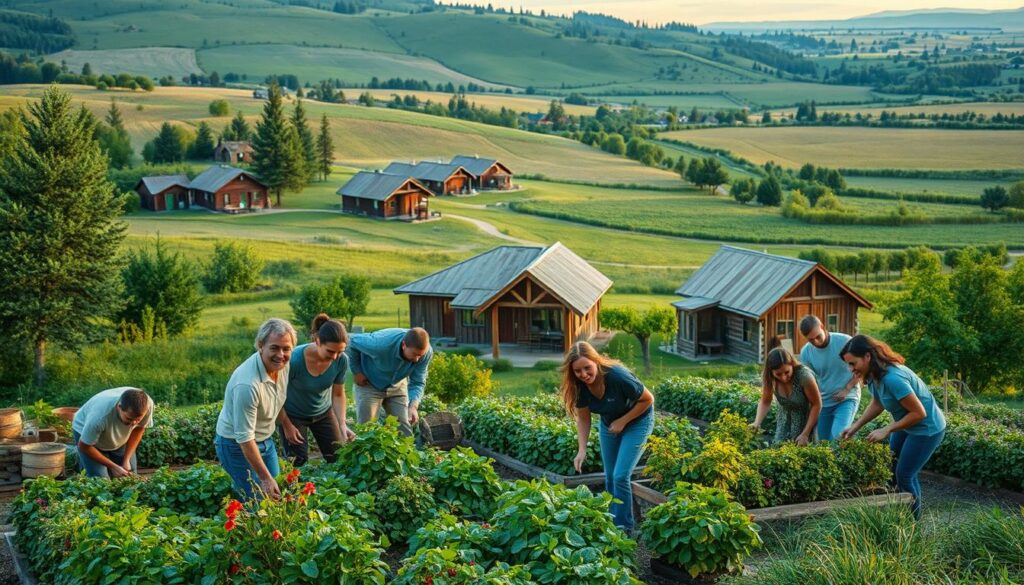
Barter systems are another way to strengthen your community. Skill/hour exchange ledgers allow you to trade expertise or labor with neighbors. This approach builds relationships while saving money and time.
Disaster response plans are crucial for any homestead. The Amish barn-raising model is a great example of how people can come together in times of need. This spirit of cooperation ensures everyone’s survival and success.
Digital tools like the Farmish app make it easier to connect with local resources. This platform helps homesteaders share equipment, seeds, and knowledge, creating a stronger community.
Take inspiration from the Oklahoma food hub, which moves $2.7M annually. This initiative shows how collaboration can create economic opportunities while supporting local families. By working together, you can achieve more than you ever could alone.
Turn Your Homestead into a Business
Transforming your homestead into a thriving business requires strategic planning and diverse income streams. According to the SBA, 43% of homestead businesses fail within 24 months. To avoid this, focus on creating multiple revenue sources and understanding the legal and financial aspects of running a successful operation.
Creating Multiple Revenue Streams
Diversifying your income is key to long-term success. Start small with ventures like $5k egg routes and scale up to $100k agritourism. This approach allows you to test different markets and find what works best for your homestead.
Choosing the right legal structure is crucial. Compare LLCs, S-Corps, and cooperative models to determine which offers the best protection and tax benefits for your business. Each structure has unique advantages, so consider your long-term goals when making a decision.
The USDA Value-Added Producer Grant is a valuable resource for homesteaders. This grant helps fund projects that increase the value of your products, such as processing or marketing. Applying for this grant can provide the financial boost needed to expand your operations.

Digital marketing is essential for reaching a wider audience. Focus on Pinterest SEO for farmstead products to attract customers and increase sales. Optimizing your online presence ensures your products stand out in a competitive market.
“Diversifying income streams and leveraging digital tools are essential for turning a homestead into a sustainable business.”
Take inspiration from Polyface Farm’s $2M/year multi-stream model. Their success demonstrates the potential of combining traditional farming with innovative revenue sources. By learning from their strategies, you can build a profitable and resilient homestead business.
- Enterprise Ladder: Start small and scale up with ventures like egg routes and agritourism.
- Legal Structures: Choose between LLCs, S-Corps, and cooperative models for optimal protection.
- USDA Grants: Apply for Value-Added Producer Grants to fund expansion projects.
- Digital Marketing: Use Pinterest SEO to boost visibility and sales for farmstead products.
- Case Study: Learn from Polyface Farm’s multi-stream model for sustainable success.
By focusing on these strategies, you can turn your homestead into a thriving business that generates steady income and supports your family’s needs.
Prepare for Challenges and Setbacks
Facing challenges is an inevitable part of the homesteading journey. According to Homesteaders of America, 82% of homesteaders experience major losses within the first five years. Being prepared can make all the difference in overcoming these obstacles.
Start with a disaster prep checklist tailored to your needs. Compare 72-hour and 30-day scenarios to ensure you’re ready for short-term emergencies or prolonged crises. Stock essentials like food, water, and medical supplies to weather any storm, especially during winter months.
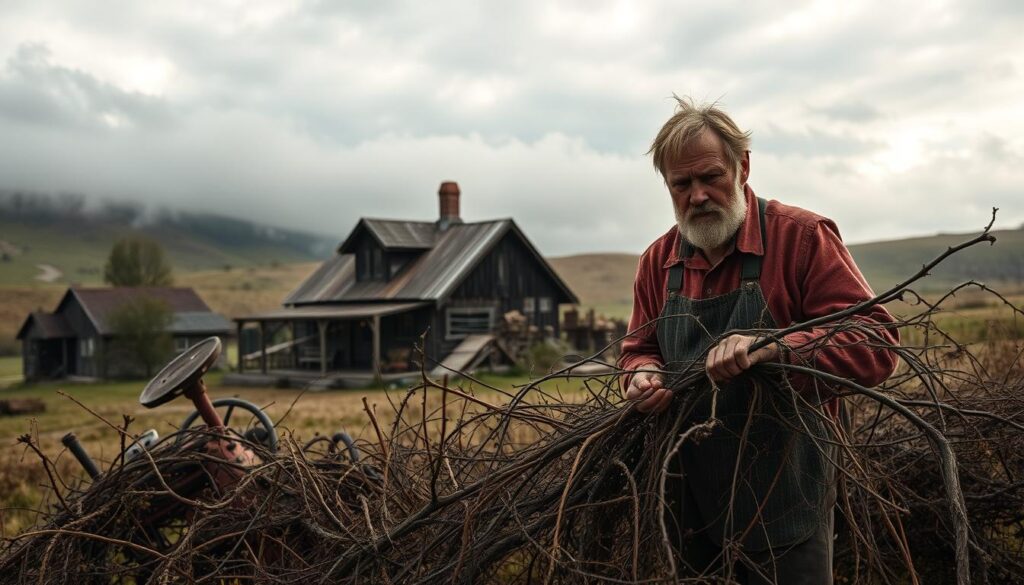
Animal care is another area where setbacks can occur. First-year poultry losses average 19%, often due to predators or illness. Secure coops and regular health checks can reduce these risks. Investing in sturdy fencing and predator-proof shelters is essential for protecting your livestock.
Mental health is just as important as physical preparedness. Resources like the Farm Aid hotline provide support for homesteaders facing stress or burnout. Building a strong support network can help you navigate tough times and stay resilient.
Insurance is a critical safety net for your homestead. Compare liability and crop coverage to find the best fit for your property. Understanding your policy ensures you’re protected against unexpected losses, from natural disasters to equipment failures.
“Preparation is the key to resilience. Every setback is an opportunity to learn and grow.”
Take inspiration from a California family who rebuilt their homestead after a devastating wildfire. Their recovery timeline highlights the importance of planning, community support, and perseverance. By learning from their experience, you can better prepare for your own challenges.
| Challenge | Solution |
|---|---|
| Disaster Preparedness | 72-hour and 30-day checklists |
| Animal Mortality | Secure coops and health checks |
| Mental Health | Farm Aid hotline and support networks |
| Insurance | Liability vs crop coverage |
| Recovery | Case study: California wildfire timeline |
By preparing for challenges, you can turn setbacks into opportunities for growth. Whether it’s a harsh winter or an unexpected loss, resilience and planning will help you thrive in your homesteading journey.
Conclusion: Begin Your Homesteading Journey Today
Your homesteading journey begins with a single step, and every effort counts toward building a sustainable future. Whether you’re on a small urban plot or a sprawling rural property, the path to self-sufficiency is within reach. With 94% of practitioners reporting improved life satisfaction, now is the time to take action.
To help you begin, consider a 30/60/90-day launch plan tailored to your property type. These step-by-step guides ensure you start strong and stay on track. For deeper insights, explore our annotated resource guide featuring the top 12 books and 8 podcasts on homesteading.
Remember, your first failure means you’re trying. Embrace the challenges as opportunities to grow. Join the #Homestead2024 challenge today and connect with a supportive family of like-minded individuals.
Homesteading isn’t a destination—it’s a daily practice. Over the years, you’ll build skills, resilience, and a deeper connection to the land. Take that first step and begin your journey today.

